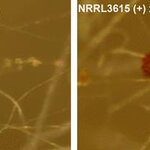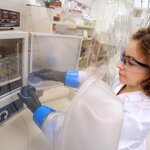Microbiology

After studying 137 varieties of cheese collected in 10 different countries, systems biologists at Harvard University have been able to identify three general types of microbial communities that live on cheese, opening the door to using each as a "model" community for the study of whether and how various microbes and fungi compete or cooperate as they form communities, what molecules may be involved in the process and what mechanisms may be involved.
"We often use model organisms like E. coli or C. elegans because they can give us an understanding of the basic mechanisms and principles of how…

Using shotgun metagenomics to sequence DNA from a calcified nodule in the pelvic region of a 700-year-old middle-aged male skeleton excavated from the settlement of Geridu in Sardinia, European researchers have recovered a genome of the bacterium Brucella melitensis.
Geridu is thought to have been abandoned in the late 14th century. Shotgun metagenomics allows scientists to sequence DNA without looking for a specific target and from this sample, the researchers recovered the genome of Brucella melitensis, which causes an infection called brucellosis in livestock and humans. In humans,…

The Centers for Disease Control and Prevention is rightfully concerned that the U.S. faces “potentially catastrophic consequences” from the growing threat of antibiotic-resistant infections, which kill about 23,000 Americans a year.
One solution is personalized antibiotic therapy, but that would require both rapid bacterial identification and narrow-spectrum antibiotics. Tailored antibiotic therapy would not only extend the clinical lifetime of new antibiotics by better managing resistance, it might also revive old antibiotics that have been abandoned due to resistance, toxicity, or their…

We all know what happens to us when we get sick, but at least we have a microbiota to protect us. What happens when those ecosystem bacteria colonizing our guts gets hit with infection?
A new computational models showed how infection can affect bacteria that naturally live in our intestines, which may help clinicians to better treat and prevent gastrointestinal infection and inflammation through a better understanding of the major alterations that occur when foreign bacteria disrupt the gut microbiota.
"Our gut contains ten-times more bacterial cells than there are human cells in our body,"…

In some parts of the world, amphibian numbers are in decline. Activists are quick to blame everything from fracking to pesticides for reduced numbers of some frogs, but scientists have linked it to an emerging fungal disease called chytridiomycosis.
New research from the National Institute for Mathematical and Biological Synthesis (NIMBioS) findss that another pathogen, ranavirus, may also contribute. In a series of mathematical models, researchers showed that ranavirus, which causes severe hemorrhage of internal organs in frogs, could cause extinction of isolated populations of wood frogs…

There is nothing more natural than sexes. Throughout evolution, living things have repeatedly developed physically distinct genders but how this happens has been a puzzle.
A discovery in the multicellular green alga Volvox carteri may be the revelation of the genetic origin of male and female sexes, showing how they evolved from a more primitive mating system in a single-celled relative.
Scientists identified the master regulatory gene for sex determination in Volvox and found that it has acquired new functions compared to a related gene in its close relative, the unicellular alga…

In September of 2013, customers of Chobani brand Greek yogurt complained of gastrointestinal problems after consuming products manufactured in the company's Idaho plant. The company issued a recall and claimed that the fungal contaminant Murcor circinelloides was only a potential danger to immunocompromised individuals.
Yet complaints of severe GI discomfort continued from otherwise healthy customers and researchers began to question the fungus and its ability to cause harm in healthy humans. Resulting research has found that this fungus is not harmless after all, but a strain with the…

An international research team has developed a new method to analyze the global genome, or the metagenome of the intestinal microbiota. The intestinal microbiota is all the bacteria found in the digestive tract. The metagenome corresponds to all the genes in these bacteria.
They believe their method method markedly simplifies microbiome analysis and renders it more powerful. The scientists have thus been able to sequence and assemble the complete genome of 238 intestinal bacteria, 75% of which were previously unknown.
In recent years, the intestinal microbiota has…

Probiotics are a popular fad but there is little evidence they are anything more than a well-marketed placebo. Like homeopathy, at least that means the only harm will be in your wallet.
Yet when something of undetermined benefit becomes a mullti-billion dollar market, scientists are going to take a look. The National Center for Complementary and Alternative Medicine isn't doing the first nationwide clinical trial to determine if probiotics work, they're busy spending $120 million a year endorsing herbs, it's instead funded by the National Institutes of Health to determine if one of the…

Chlorinated chemicals perform a host of societally useful functions, but they're not perfect. Once their use life has ended, they can become environmental contaminants and even resistant to bioremediation.
In a series of new studies, Anca Delgado, a researcher at Arizona State University's Biodesign Institute, examines unique groups of microorganisms, capable of converting hazardous chlorinated chemicals like trichloroetheene (TCE) into ethene, a benign end product of microbial biodegradation. The new studies explore the metabolic activities of a group of microbes known as Dehalococcoides,…